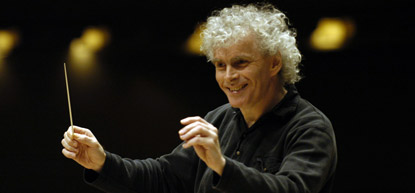Sir Simon Rattle returned to Los Angeles this past weekend to conduct the LA Philharmonic in an ambitious program including Atmosphères by György Ligeti, the Prelude to Act I of Lohengrin by Wagner, the Rückert-Lieder by Mahler featuring mezzo-soprano Magdalena Kozená, and the Symphony No. 9 in D minor by Bruckner.
Rattle, who was last in LA in 2009 with his house band, the Berlin Philharmonic, began the program on Saturday, May 5, with the Ligeti, in which the composer replaces traditional musical form with tone clusters where several consecutive notes on a scale are played simultaneously. As has been noted many times, the piece was used by Stanley Kubrick for the monolith and the deep space scenes in his movie 2001: A Space Odyssey. Despite the absence of harmony or melody in the piece, the LA Phil’s performance was spellbinding.
Rattle then transitioned into the Wagner without interruption (interestingly, Vladimir Jurowski had done something similar in a 2008 concert with the London Philharmonic transitioning from Atmosphères to Stravinsky’s Rite of Spring), which proved to be very effective not only because it prevented the audience from applauding, but also because the waning sounds of the high violins in the Ligeti were not unlike the opening notes played by the violins in the Wagner, giving the impression that the two pieces were two parts of a whole. Rattle and the LA Phil offered a luscious, but controlled rendition of the Lohengrin Prelude which slowly moves, over its eight-minute length, from the quietest of strings to a cymbal-crashing crescendo with the entire orchestra before fading back to end, as it began, with the violins playing in the high registers.
With the almost one-hour Bruckner ninth symphony on the second half of the program, the Ligeti and Wagner would have been sufficient musical fare for a first half. But Rattle wasn’t through just yet. He then brought out mezzo-soprano (and his wife) Kozená for a performance of the Rückert-Lieder. These brief songs, sparsely orchestrated by Mahler and intimately rendered by Rattle, were sung brilliantly and with just the right emotion by Kozená. Her voice blended seamlessly with the orchestra, and Rattle made sure her singing could be heard at all times.
Rattle concluded the concert with a moving performance of Bruckner’s last, and unfinished, symphony. Interestingly, throughout most of the piece, Rattle focused his attention on the string sections, instead of cueing the many woodwind and horn entrances. The result was a performance with an increased sense of despair and urgency.
Bruckner’s strong religious conviction can be gleaned from several of his symphonies, but none more so than the ninth, which was dedicated to “dem leiben Gott” (“to the beloved God”). Perhaps it was because he knew he was dying and might not get to finish it — hence, his comment about the third movement being his “farewell to life,” and the markings of Feierlich (solemn) in the first and third movements. As Richard Lehnert recently wrote on Stereophile.com in contemplating the addition of Bruckner’s extensive sketches of a fourth movement, “What earthly music could possibly follow such an embodiment in sound of pain and suffering, followed by hard-won peace fading out at the last into barely audible acceptance?”
Indeed, one could ask this question following the ravishing performance on Saturday night by Rattle and the LA Phil. In fact, even applause following the last sustained notes in the horns seemed sacrilegious.
Rattle had the LA Phil playing at their very best on Saturday night, and the orchestra acknowledged their appreciation when they stomped their feet during his final curtain call.
In this video, hear Sir Simon Rattle talk about the “new” fourth movement of Bruckner’s ninth symphony, his recording of which is slated to be available later this month:
https://www.youtube.com/watch?v=Z9Jlgh_gpSs&feature=player_embedded






